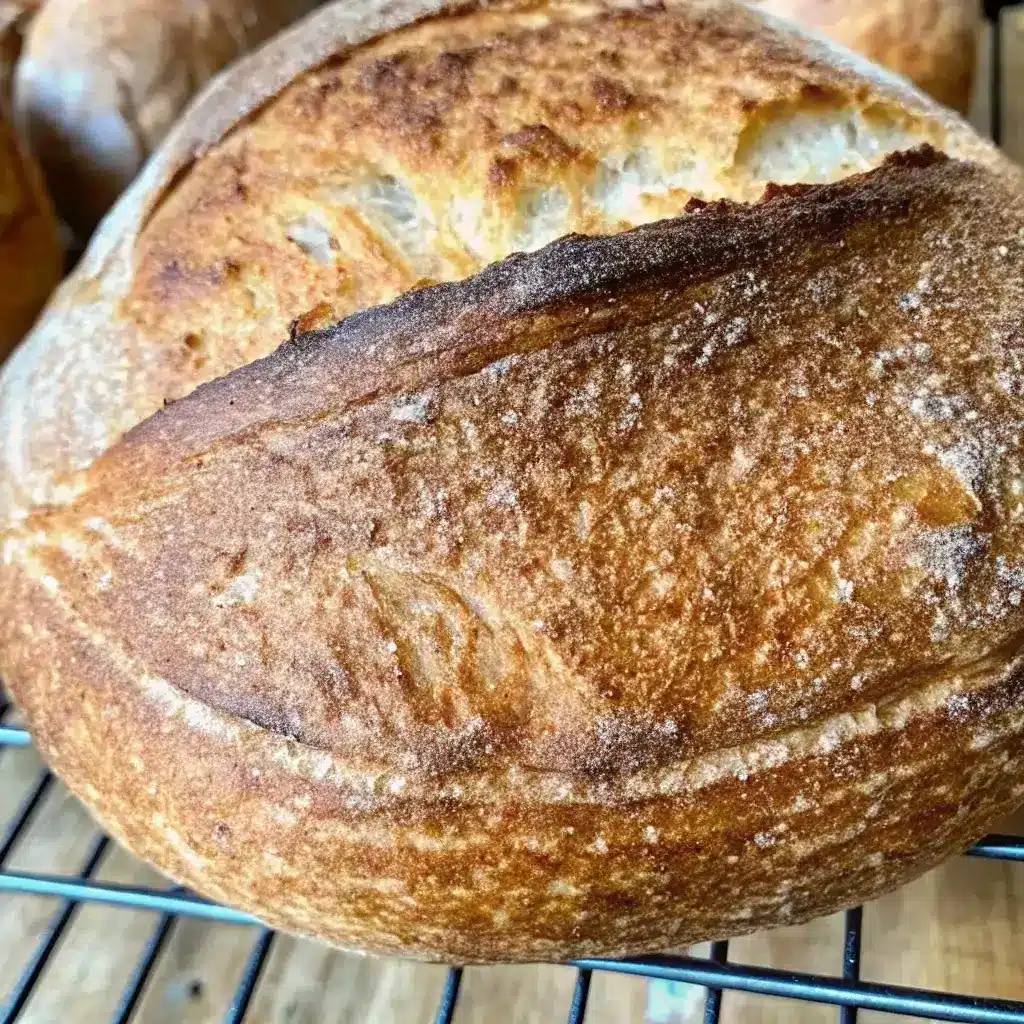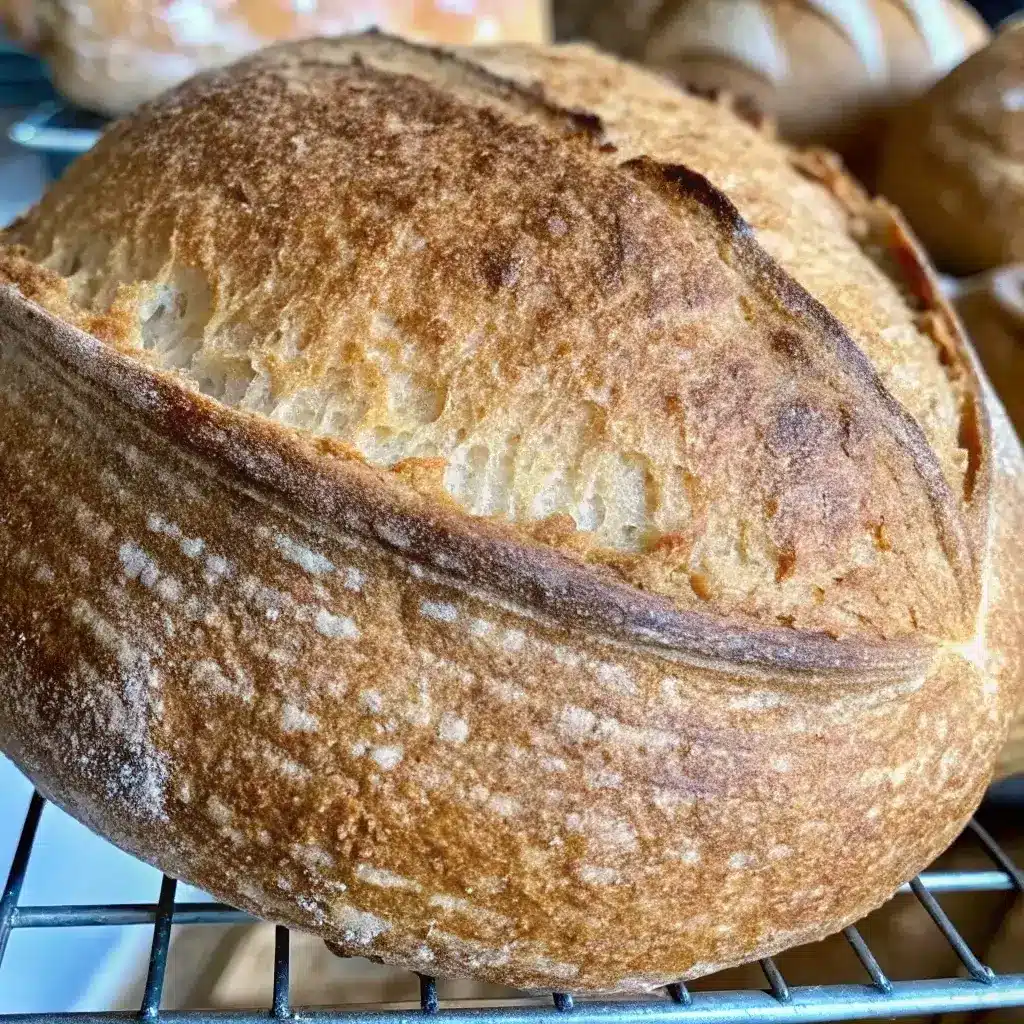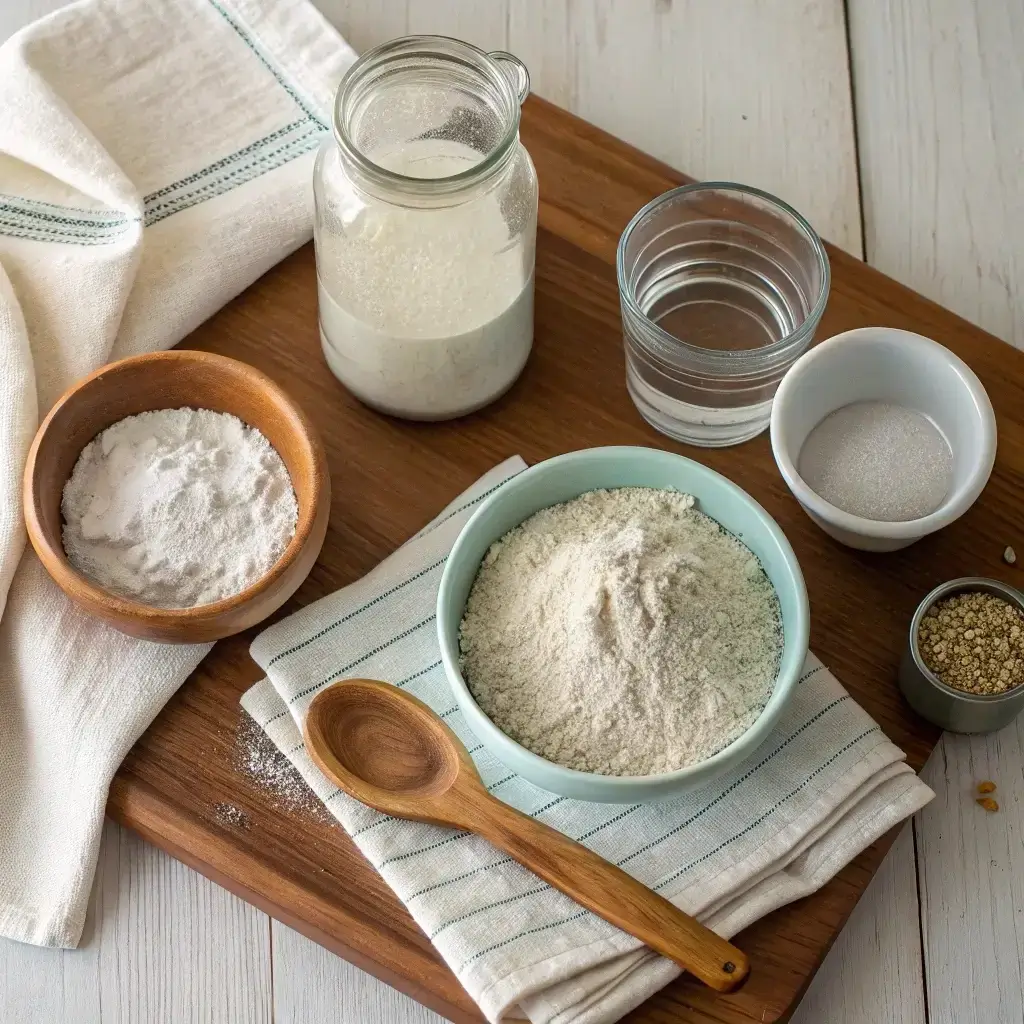Organic sourdough bread is more than just a rustic trend—it’s a nourishing, gut-friendly staple with real benefits. Unlike conventional loaves, organic sourdough is made from clean, chemical-free ingredients and naturally fermented for better digestion and deeper flavor. Whether you’re wondering if Trader Joe’s sourdough is the real thing or trying to spot authentic options on shelves, this guide will walk you through what matters. From health benefits to sourcing tips and even homemade recipes, we’ll cover everything you need to know to make the switch with confidence—and maybe even start baking it yourself.
Table of Contents

Rediscovering Organic Sourdough Bread
What Makes It “Organic” and “Sourdough”
There’s bread—and then there’s organic sourdough bread. At its core, it’s a simple mix of organic flour, filtered water, and sea salt, fermented naturally with a wild yeast starter. But don’t be fooled: not all “sourdough” is created equal. Many grocery store brands shortcut the process with commercial yeast or skip fermentation altogether.
Organic means the wheat used hasn’t been touched by pesticides, glyphosate, or synthetic chemicals. That matters, especially when you’re looking for something to support gut health or lower inflammation. If you’re curious about how organic and fermentation work together, this article on low-FODMAP sourdough bread offers helpful science-backed insights.
The key is fermentation. Real sourdough takes time—anywhere from 12 to 36 hours—which breaks down gluten, improves mineral absorption, and gives it that rich, tangy flavor. Choosing organic sourdough bread ensures you’re not just getting nutrients, but avoiding what your body doesn’t need.
Why I Fell in Love With This Bread
I didn’t grow up eating sourdough. It wasn’t until I became a single mom and found myself navigating picky eaters that I stumbled onto its magic. My twins hated veggies, but when I started experimenting with homemade sourdough, something shifted. That golden, chewy crust became our new comfort food. It reminded me that real food could be healing, not just filling.
The first time I used a starter for croissant sourdough bread, it flopped—but I kept going. Eventually, we were making weekly loaves using organic flours and clean ingredients. If you’ve ever wondered where to begin, this gluten-free sourdough how-to is a great place to start.
From a frustrated mom to a confident home baker, sourdough changed my kitchen—and my family’s health—for good.
Health Benefits You Can Taste and Feel
Why Organic Sourdough Bread Is Healthier Than Regular Bread
Let’s be honest: bread has gotten a bad reputation in recent years. But organic sourdough bread flips the script. Unlike conventional loaves filled with preservatives, commercial yeast, and refined flour, organic sourdough bread is crafted through a natural fermentation process that enhances both flavor and nutrition.
The beauty of sourdough lies in its time. It’s not rushed. This extended fermentation breaks down gluten, making the bread easier to digest. It also reduces phytic acid, which allows your body to absorb minerals like iron, zinc, and magnesium more efficiently. Combine that with organic ingredients—no pesticides, no synthetic additives—and you get a clean, nourishing loaf that supports your wellness goals.
If you’re someone who struggles with blood sugar spikes or digestive discomfort, organic sourdough bread is worth a try. Because of its naturally lower glycemic index, it helps regulate blood sugar and provides steady energy throughout the day. That’s one of the reasons I keep it stocked (and baked!) regularly in my kitchen.
Looking for a lighter option? Low-calorie sourdough bread keeps things heart-healthy without sacrificing texture or taste.
What the Science Says About Organic Sourdough Nutrition
Research shows that sourdough fermentation produces beneficial bacteria that feed your gut microbiome—key to immunity and long-term health. BBC Good Food and Healthline both report that sourdough supports digestive health, aids mineral absorption, and may reduce inflammation.
But don’t just take their word for it. Dig into the numbers in this nutrient-focused guide to calories in sourdough bread, which explains how organic sourdough bread can support a balanced diet without the crash.
Whether you’re pairing it with soups, slicing it for toast, or building the perfect sandwich, organic sourdough bread is a smart and satisfying upgrade to your daily meals—and a delicious way to support your body from the inside out.
Can You Really Buy Organic Sourdough Bread?
What to Look for at the Grocery Store
So you’re standing in front of a shelf labeled “sourdough.” But is it really sourdough? And more importantly, is it organic sourdough bread?
Most store-bought “sourdough” isn’t truly fermented. Instead, it mimics the flavor with vinegar or souring agents—and still uses commercial yeast to speed up the rise. When you’re shopping, turn the loaf over and read the ingredients. Real organic sourdough bread should contain only a few basics: organic flour, water, sea salt, and maybe olive oil. If you see yeast, dough conditioners, or preservatives, it’s not the real thing.
Even trusted brands can mislead. For instance, while Trader Joe’s offers some “sourdough-style” loaves, they often lack the traditional fermentation process that gives organic sourdough bread its gut-health benefits. San Luis Sourdough looks rustic, but reviews suggest it may use shortcuts that compromise authenticity and digestion. The difference is more than flavor—it’s about health and integrity.
Want a shortcut? Save this tip: if it doesn’t mention “long fermentation” or “starter culture,” it’s likely not a true sourdough. And if it isn’t certified organic, you’re missing out on pesticide-free, nutrient-rich ingredients that make a big difference.
Best Places to Buy or Order Real Organic Sourdough
I’ve had the most luck finding real organic sourdough bread at local bakeries and farmer’s markets. Many artisan bakers care deeply about using wild starters and organic flours. If you’re unsure where to start, I recommend trying sourdough pita bread or small-batch croissant sourdough bread from known quality-first brands.
And if you want full control over the ingredients? Homemade is best. In fact, I’ve found that baking at home delivers not just better bread, but peace of mind. Once you get into the rhythm of feeding your starter and letting your dough ferment, you’ll never go back to the store stuff.

Organic Sourdough Bread
Ingredients
Equipment
Method
- Combine the sourdough starter and warm filtered water in a large bowl and stir to dissolve. Add honey if using.
- Add both flours and mix until a shaggy dough forms. Let rest for 30 minutes.
- Add sea salt and knead for 5–6 minutes until smooth. Cover and let rest for 1 hour.
- Perform 3 rounds of stretch and folds, spaced one hour apart. Cover between each set.
- Let the dough bulk ferment for 3–12 hours or until nearly doubled and airy.
- Turn dough onto a lightly floured surface, shape into a rectangle, fold sides, and roll into a log. Shape again and place into a floured banneton.
- Proof at room temperature or cold ferment in the fridge overnight for better flavor.
- Preheat Dutch oven to 450°F. Score the dough and bake covered for 20 minutes, then uncovered at 400°F for 30 more minutes.
- Cool the loaf on a wire rack for at least 1 hour before slicing.
Nutrition
Notes
Tried this recipe?
Let us know how it was!Making Organic Sourdough at Home
Sourdough Bread Ingredients
Making organic sourdough bread at home may seem intimidating at first, but it’s simpler and more rewarding than it sounds. It all begins with a healthy sourdough starter—a mixture of flour and water that captures wild yeast and jumpstarts fermentation. Use 150 grams of bubbly, active organic sourdough starter that has been fed regularly with unbleached, non-GMO flour until it doubles in size. If you’d rather skip the feeding routine, you can purchase a live starter from a reputable organic baker, but creating your own builds a deeper connection to the craft.
Once your starter is ready, the rest of the ingredients come together easily: 500 grams of flour (I love combining 460g of bread flour with 40g of rye for added depth), 350–360 grams of warm, filtered water (avoid distilled or reverse osmosis), 15 grams of pure fine sea salt, and optionally, 30 grams of raw, organic unfiltered honey. The honey not only adds a touch of sweetness but also helps nourish the wild yeasts—especially useful in cooler kitchens. Whether you’re a beginner using high-protein bread flour for a stronger structure or experimenting with whole grains, patience and quality ingredients are the foundation of flavorful organic sourdough bread.

For more fun variations and ideas, check out our Facebook and Pinterset sections where creativity meets craving.
How to Make Organic Sourdough Bread at Home
Once you’ve got a bubbly, active starter, making organic sourdough bread becomes a rhythm of simple, satisfying steps—mixing, stretching, and resting. Start by combining your starter and warm, filtered water in a large bowl until dissolved. Add raw organic honey if using, then stir in the flour until a shaggy dough forms. Finally, mix in the sea salt and knead until smooth—about 5–6 minutes. Cover with a damp towel and let it rest for an hour.
From here, it’s all about building strength through stretch and folds. With wet hands, perform a set of folds every hour for three rounds, allowing the dough to rest in between. Your bulk fermentation can take anywhere from 3 to 12 hours depending on your kitchen climate—mine typically finishes in 3–4 hours in humid Florida. You’ll know it’s ready when the dough has nearly doubled in size, has air bubbles, and feels smooth but not sticky.
Next, shape your dough on a lightly floured surface by stretching it into a rectangle, folding in the sides, and rolling it up like a burrito. Let it rest, then shape again for added tension and transfer seam-side-up into a floured banneton basket. At this point, you can either bake the same day or cold ferment overnight for a deeper flavor.
Baking is straightforward: preheat your Dutch oven to 450°F. Score the dough, bake for 20 minutes with the lid on, then 30 minutes at 400°F uncovered. Cool for at least an hour.
The result? A crackly crust, soft interior, and that unmistakable sour tang you can only get from true organic sourdough bread. Once you experience the joy of baking your own loaf—free of additives and full of intention—you’ll never look at store-bought the same way again.
Frequently Asked Questions About Organic Sourdough Bread
Is organic sourdough bread healthy?
Yes, organic sourdough bread is a nutrient-rich, gut-friendly option. Its natural fermentation process improves digestion, lowers gluten levels, and increases mineral absorption. When made with organic ingredients, you also avoid pesticide residues, synthetic additives, and preservatives—making it one of the cleanest bread choices you can enjoy regularly.
Can you get organic sourdough bread?
Absolutely! You can find organic sourdough bread at local artisan bakeries, some health food stores, and online from trusted bakers. Just be sure to read the ingredients. Look for certified organic flour, no commercial yeast, and a mention of long fermentation. Better yet, consider baking it at home for full control and unbeatable flavor.
Is Trader Joe’s sourdough healthy?
Trader Joe’s sourdough-style bread may taste decent, but many of their options don’t go through a full natural fermentation process. Some contain added yeast or preservatives, which means they may not offer the full health benefits of true sourdough. For the most health-supportive option, opt for long-fermented and organic sourdough bread with minimal ingredients.
Is San Luis sourdough real sourdough?
San Luis sourdough is popular for its texture and tang, but it’s not always made with traditional fermentation methods. Some versions may include commercial yeast, which means they rise faster but miss the deep digestive and nutritional benefits of authentic sourdough. Always check the label, or better yet, make your own for guaranteed quality.
Conclusion
Organic sourdough bread isn’t just another health trend—it’s a return to tradition, flavor, and food that loves you back. From its natural fermentation to its clean, organic ingredients, this bread brings together nourishment and simplicity in the most delicious way.
Whether you’re shopping smarter at the store, questioning brands like Trader Joe’s or San Luis, or trying your hand at homemade sourdough, the journey is worth it. You’ll feel the difference in your gut, your energy, and your kitchen pride.
So here’s your nudge: give organic sourdough bread a real place at your table. Bake it. Share it. Savor it. Your body—and your taste buds—will thank you.
